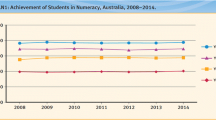Abstract
International and national testing of numerical and language skills has become a regular part of educational systems in many countries. In Australia, the National Assessment Program—Literacy and Numeracy (NAPLAN) has been used since 2008 to carry out regular tests of literacy and numeracy amongst school students nationally. Since the numeracy components of this program are based on work carried out in school mathematics classes, it seems reasonable that tests represent an evaluation of mathematical ability, albeit at the simpler and introductory levels. However, there has been little investigation of students’ ideas about numeracy, and the role that their attitudes towards numeracy may have on their results on the numeracy components of NAPLAN tests. This study carries out an empirical investigation of ideas about and attitudes towards numeracy, and their relation to NAPLAN scores for a sample of 735 lower secondary students from two schools in New South Wales, Australia. Attitudes are measured using a modified form of the Students’ Attitudes Towards Statistics, (SATS-36) test (Schau in Survey of attitudes towards statistics, http://www.evaluationandstatistics.com, 2003), and conceptions of numeracy are obtained from phenomenographic analysis of an open-ended response item. The overall conclusion, that students’ understanding of the concept of numeracy and their attitudes towards numeracy are related to their performance in numeracy tests, represents a potentially important result both for students and their teachers.
Similar content being viewed by others
References
AAMT. (1998). Policy on numeracy education in schools. Australian Association of Mathematics Teachers Inc. Retrieved from http://www.aamt.edu.au/content/download/724/19518/file/numpol.pdf.
ACARA. (2011). NAPLAN. Retrieved from http://www.nap.edu.au/naplan/naplan.html, http://www.nap.edu.au/information/faqs/naplan–general.html and http://www.nap.edu.au/naplan/numeracy/minimum-standards—numeracy.html.
ACARA. (2013). My school. Retrieved from http://www.myschool.edu.au/MoreInformation.
Åkerlind, G. S. (2008). A phenomenographic approach to developing academics’ understanding of the nature of teaching and learning. Teaching in Higher Education, 13(6), 633–644.
Belcastro, L., & Boon, H. (2012). Student motivation for NAPLAN tests. Australian and International Journal of Rural Education, 22(2), 1–19.
Carmichael, C., Callingham, R., Hay, I., & Watson, J. (2010). Statistical literacy in the middle school: The relationship between interest, self-efficacy and prior mathematics achievement. Australian Journal of Educational & Developmental Psychology, 10, 83–93.
Carmichael, C., MacDonald, A., & McFarland-Piazza, L. (2014). Predictors of numeracy performance in national testing programs: Insights from the longitudinal study of Australian children. British Educational Research Journal, 40(4), 637–659.
Chiesi, F., & Primi, C. (2010). Cognitive and non-cognitive factors related to students’ statistics achievement. Statistics Education Research Journal, 9(1), 6–26.
Creagh, S. (2014). A critical analysis of problems with the LBOTE category on the NAPLAN test. Australian Educational Researcher, 41, 1–23.
Fishbein, M. (1967). Readings in attitude theory and measurement. New York: Wiley.
Gal, I. (2003). Teaching for statistical literacy and services of statistics agencies. The American Statistician, 57(2), 80–84.
Geiger, V., Goos, M., & Dole, S. (2015). The role of digital technologies in numeracy teaching and learning. International Journal of Science and Mathematics Education, 13(5), 1115–1137.
Goos, M., Dole, S., & Geiger, V. (2011). Improving numeracy education in rural schools: A professional development approach. Mathematics Education Research Journal, 23, 129–148.
International Association for the Evaluation of Educational Achievement (IEA). (2014). TIMSS & PIRLS. Lynch School of Education, Boston College. Retrieved from http://timssandpirls.bc.edu/.
Johnson, R.L. (2011). The relationship between attitude and academic achievement among seventh and eighth grade African American males. (Doctoral dissertation), Retrieved from ProQuest Digital Dissertations (UMI Number: 3484770).
Li, L. K. Y. (2012). A study of the attitude, self efficacy, effort and academic achievement of City-U students towards research methods and statistics. Discovery-SS Student E-Journal, 1, 154–183.
Liddell, M., & Davidson, S. (2004). Student attitudes and their academic performance: Is there any relationship? Medical Teacher, 26(1), 52–56.
Loughland, T., Reid, A., & Petocz, P. (2002). Young people’s conceptions of environment: A phenomenographic analysis. Environmental Education Research, 8(2), 187–197.
Marton, F., & Booth, S. (1997). Learning and awareness. Mahwah: Lawrence Erlbaum.
Mickelson, R. A. (1990). The attitude-achievement paradox among black adolescents. Sociology of Education, 63(1), 44–61.
Organisation for Economic Co-operation and Development (OECD). (2012). Programme for International Student Assessment (PISA). Retrieved from http://www.oecd.org/pisa/home/.
Perso, T. (2011). Assessing numeracy and NAPLAN. Australian Mathematics Teacher, 67(4), 32–35.
Petocz, P., & Reid, A. (2010). On becoming a statistician—A qualitative view. International Statistical Review, 78(2), 271–286.
Pierce, R., & Chick, H. (2011). Teachers’ intentions to use national literacy and numeracy assessment data: A pilot study. Australian Educational Researcher, 38, 433–447.
Polesel, J., Dulfer, N. & Turnbull, M. (2012). The experience of education: The impacts of high stakes testing on school students and their families. Whitlam Institute, University of Western Sydney. Retrieved from http://www.whitlam.org/__data/assets/pdf_file/0008/276191/High_Stakes_Testing_Literature_Review.pdf.
Ragland, D. (2008). Attitude variables affecting student achievement. Doctoral Dissertation, Retrieved from ProQuest Digital Dissertations (UMI Number: 1455104).
Schau, C. (2003). Survey of attitudes towards statistics. Retrieved from http://www.evaluationandstatistics.com.
Schau, C., Millar, M., & Petocz, P. (2012). Research on attitudes towards statistics. Statistics Education Research Journal, 11(2), 2–5.
Thompson, G., & Harbaugh, A. G. (2013). A preliminary analysis of teacher perceptions of the effects of NAPLAN on pedagogy and curriculum. Australian Educational Researcher, 40, 299–314.
Trey Hill, W., & Brase, G. (2012). When and for whom do frequencies facilitate performance? On the role of numerical literacy. The Quarterly Journal of Experimental Psychology, 65(12), 2343–2368.
Wood, L., Petocz, P., & Reid, A. (2012). Becoming a mathematician: An international perspective. Dordrecht: Springer.
Author information
Authors and Affiliations
Corresponding author
Rights and permissions
About this article
Cite this article
Parnis, A.J., Petocz, P. Secondary school students’ attitudes towards numeracy: an Australian investigation based on the National Assessment Program—Literacy and Numeracy (NAPLAN). Aust. Educ. Res. 43, 551–566 (2016). https://doi.org/10.1007/s13384-016-0218-3
Received:
Accepted:
Published:
Issue Date:
DOI: https://doi.org/10.1007/s13384-016-0218-3




